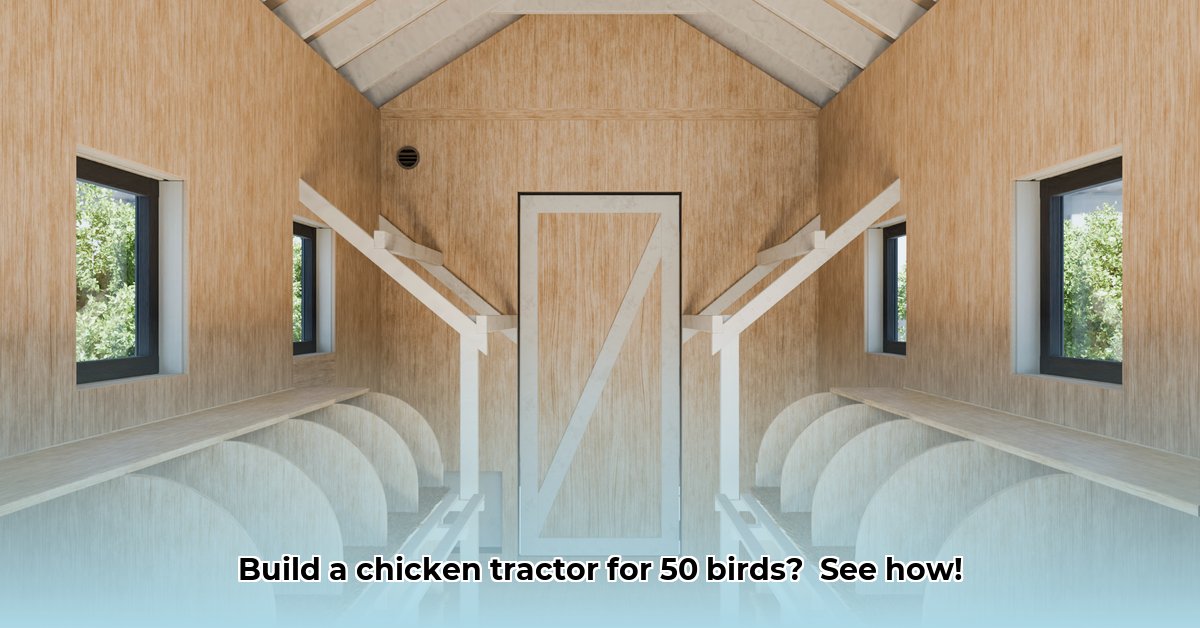
Want fresh, farm-fresh eggs every morning without the commitment of a permanent coop? Building a chicken tractor is the perfect solution! This comprehensive guide will walk you through constructing a mobile coop perfect for 50 chickens, covering everything from planning and material selection to predator protection and long-term maintenance. Even if you're a complete beginner, you'll be able to build a safe and comfortable home for your feathered friends. For even more detailed plans, check out these chicken tractor plans. Let's get started!
Planning Your Chicken Tractor: Considerations for Success
Before you pick up a hammer, careful planning is essential. Fifty hens require ample space – experts recommend 100 to 150 square feet (approximately a 10-foot by 15-foot rectangle). Measure your yard to identify a suitable location.
Next, consider your tractor's mobility. A larger tractor offers more space; however, moving it might be more challenging. Conversely, a smaller, more easily maneuverable tractor might feel cramped for your flock. Weigh the convenience of moving it versus the space provided for your chickens. Remember, happy hens lay more eggs! Is the extra effort worth it for improved egg production?
Gathering Your Supplies: A Detailed Materials List
This list provides estimates for a sturdy chicken tractor for 50 chickens. Adjust quantities based on your specific design.
| Material | Quantity (Estimate) | Notes |
|---|---|---|
| 2x4 Lumber | ~100 linear feet | For the framework. Pressure-treated lumber is recommended for durability. |
| 1/2" Plywood | 2 sheets (4' x 8') | For the floor and walls. Consider using salvaged or reclaimed wood to save money. |
| Hardware Cloth | Sufficient coverage | 1/2" mesh or smaller to deter predators. Secure it tightly! |
| Roofing Material | As needed | Metal roofing is durable. Consider your climate when making this choice. |
| Heavy-Duty Hinges | Several | Quality hinges are crucial for long-term functionality. |
| Screws & Nails | As needed | Weather-resistant screws and nails are essential for longevity. |
| Heavy-Duty Wheels | 4 | Choose wheels capable of supporting the weight of the filled structure. |
| Roosting Bars | Sufficient Length | Aim for 8-10 inches of roosting space per chicken. |
| Nesting Boxes | 12-13 | Individual nesting boxes provide privacy. |
Building Your Chicken Tractor: A Step-by-Step Guide
Follow these steps to construct your chicken tractor. Each step is clearly explained to ensure a successful build.
Building the Foundation (Frame): Construct a sturdy rectangular frame using your 2x4s. Ensure it's square and secure using plenty of screws. The frame's dimensions determine the tractor's size – double-check your measurements!
Creating a Solid Floor: Attach plywood sheets to the frame for a stable and level floor. Secure fastening is key.
Constructing the Walls: Add walls to the frame, using more 2x4s and plywood. Attach hardware cloth to the inside of the walls for predator protection. Ensure tight, secure fastening to prevent escapes.
Building a Weatherproof Roof: Attach your roofing material to create a waterproof roof to shield your chickens from the elements. Consider adding roofing felt under metal roofing for extra protection.
Adding Convenient Doors: Install multiple access doors using hinges for easy cleaning and feeding. Secure latches are crucial to prevent escapes.
Providing Roosting Space: Create roosting bars using 2x4s or similar material. Provide sufficient space—at least 8-10 inches per chicken.
Creating Nest Boxes: Construct individual nesting boxes to provide your hens with private egg-laying spaces.
Adding Mobility with Wheels: Securely attach heavy-duty wheels to the frame, ensuring they can handle the combined weight of the structure and the chickens. Consider a tongue for easier maneuverability.
Final Inspection and Adjustments: Thoroughly inspect the completed tractor, addressing any weak points or gaps that might compromise predator protection.
Predator Protection: A Critical Stage
Protecting your flock is paramount. Predators pose a significant threat. Utilizing high-quality hardware cloth (at least 1/2-inch mesh) on all sides and burying the bottom edge several inches into the ground is crucial. Double-check all seams and corners for weaknesses, ensuring all access points are fully secured. This is critical for the health and safety of your chickens.
Maintaining Your Chicken Tractor: A Long-Term Perspective
Regular maintenance is vital. Clean the tractor frequently to maintain a healthy environment. Regularly inspect the structure for damage, repairing or replacing parts as needed. Preventative maintenance ensures a longer lifespan for your chicken tractor and happier, healthier hens. Remember, a well-maintained chicken tractor equals more eggs!
Optimizing Your Chicken Tractor Design for 50 Chickens
This section focuses on building a cost-effective and efficient chicken tractor.
Key Considerations for Cost-Effectiveness:
- Recycled Materials: Using reclaimed lumber, pallets, and repurposed materials can drastically reduce costs.
- Prioritize Functionality: Focus on creating a safe, functional structure; elaborate aesthetics are secondary.
- Adaptability: Design your tractor to suit your specific needs and climate.
Adapting the Design to Your Specific Needs
Remember to adjust this plan based on your local climate and available resources. Consider factors such as wind, rain, and potential temperature extremes. A well-designed chicken tractor should protect your flock throughout the year.